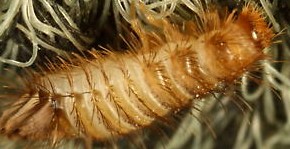Texas is a great place to live, a fact that those living in this great state already knew, and the growing number of Americans relocating here are attesting to. In 2019 alone, more than 500,000 people moved to Texas from other states (most commonly California). And though these new residents are sure to be in for a treat with everything the Lone Star state has to offer, they first need to find and settle into new housing, a daunting task even before considering the pest control concerns that need to be taken into account. One pest that can often fly under the radar until well after an infestation has been established is the carpet beetle. These small pests are infamous for causing property damage but are often only detected after the damage has been done. Though it may be the last thing on your mind, keeping an eye out for signs of carpet beetles during a move (both in the home you are moving from and the one you are moving to) can spare you a lot of heartache and work down the road. And for those not currently in the midst of a move, it’s always important to keep your eyes open for the signs of an infestation and take preventative measures to keep your household belongings in excellent condition.

What do Carpet Beetles Look Like?
There are 3 main types of carpet beetles found in the U.S.: varied carpet beetles, furniture carpet beetles, and black carpet beetles. Though there are some physical and behavioral differences between the 3, they are overall substantially similar. Adults are approximately 1/10th to 3/16th inches long and have rounded or oblong bodies (about the shape of a lady bug, only smaller). They can range in coloring from mottled brown and white to dark brown or shiny black, and can have yellow/orange scales on their wings that they will lose as they age. Larval carpet beetles are elongated and are bigger than their adult form, measuring 1/8th to 1/4th inch long. They can range from tan to brown in color and have stiff hairs coming off their bodies. As they grow, they will leave behind shed exoskeletons until they reach pupation (anywhere from 6 months to nearly 2 years after hatching). Carpet beetle eggs are tiny (less than a millimeter in size), white, and oval-shaped.

Where do Carpet Beetles Live?
Adult carpet beetles are predominantly found outdoors, generally on the blossoms of crape myrtles, Queen Anne’s lace, daisies, and other flowering plants rich in pollen. When discovered indoors they are generally near doors or windows, though they can also be found in bird or rodent nests.
Carpet beetles in their larval stage can be found throughout the home in dark, undisturbed areas. Common locations are: in pantry goods, in stored natural-fiber fabrics, and in areas where dead insects accumulate.
What do Carpet Beetles Eat?
Adult carpet beetles feed on pollen and nectar from flowering plants and as such are relatively harmless.
Larval carpet beetles generally consume foods high in protein, but can also feed on plant material and are able to digest foods containing keratin. As such their diet can be diverse and includes powdered milk, dried meats, pet food, wool, felt, fur, feathers, dead insects, leather, silk, hair, and dried plant products. They do not, however, eat synthetic fibers, though they can be drawn to them if they are stained with body oils or food.

Are Carpet Beetles Dangerous?
Neither adult nor larval carpet beetles bite or sting humans or pets, though the hairs on the larvae can irritate skin when they come in contact. Adults are generally not considered harmful except in that adult females can lay their eggs indoors, and these eggs will hatch into the destructive larvae.
Larval carpet beetles are known to do a lot of damage to a wide assortment of household items such as rugs, linens, draperies, upholstery, clothing, furniture, pillows, taxidermied animals, as well as infesting stored foods. If you notice a natural-fiber item with damage (i.e. irregular holes or threadbare spots) to a large area on only one section (as opposed to scattered holes) there is a high chance that the damage is due to carpet beetle larvae; if you find shed exoskeletons alongside the damage you can be virtually certain that they are the culprit. With adult females laying between 50 and 100 eggs near food sources, and the food sources of choice being in heavily undisturbed areas, the damage can add up quickly before you even know you have a problem.

How do you Prevent Carpet Beetles?
There are 2 crucial steps to preventing a carpet beetle infestation: exclusion and sanitation. In order to protect your belongings from attack, the first step needs to be keeping the adult beetles from entering your home. This is best achieved by utilizing intact window and door screens, removing any wasp, bird or animal nests around your home, and inspecting any plants or flowers for beetles prior to bringing them indoors.
Sanitation is a bit more time-consuming but is the only way to prevent carpet beetle larvae from getting a foothold in your home. Examples of important sanitation procedures are:
- Maintain regular pest control service with The Bug Dude to keep other pest infestations from becoming a buffet for carpet beetle larvae.
- Immediately clean up any accumulations of hair, pet fur, and dead insects (look for them in spiderwebs, light fixtures, etc.).
- Regularly clean carpets, rugs, drapes, and upholstered items, especially along edges and in any cracks and crevices.
- Inspect natural-fiber or animal-based items annually (i.e. leather, wool, down, or silk clothing or linens, or taxidermied animals).
- Keep pantry items in sealed containers.
- Inspect and clean closets, attics, and any other areas of long-term storage regularly.
- Thoroughly wash fabrics between uses and store in sealed containers.
- After vacuuming any areas of suspected carpet beetle activity, immediate empty the vacuum in an outdoor trash can.
- If there has been prior rodent activity in the home, check for nests or food caches under cabinets and in other unused nooks.
How do you Eliminate Carpet Beetles?
Once carpet beetles have invaded your home, the first step is to call The Bug Dude at 1-800-310-BUGS (2847) to have an experienced technician help you track down the source(s) of the infestation and eliminate them. In the meantime, any items that have been discovered with damage should either be disposed of or properly handled to destroy the pests living on them. If the item can be laundered, wash it in hot water and dry it thoroughly, or dry clean the item. For items that cannot be laundered and aren’t too large, heating or freezing may be an option (depending on the item in question and its relative safety in those environments). Items need to be either frozen for at least 2 weeks at temperatures below 18°F or heated for at least 30 minutes at temperatures over 120°F. Any specialty items should be handled by an expert in cleaning those specific items (i.e. furs or mounted game trophies).
Carpet beetles are known for being one of the most difficult pests to detect and control because they can be anywhere within a home. This makes moving the most ideal time to inspect for these pests, as it’s the one time you will be going through every item in your home, and also the only time you can inspect a completely empty home for signs of activity or conducive conditions. If you find any signs of infestation or are concerned about potential high-risk areas, give The Bug Dude a call at 817-354-5350 and let us help you keep your new home and your cherished possessions beetle-free.
Further Reading:
“A massive number of people are relocating to Texas from these 2 states” – Lindsey Wilson – CultureMap Dallas
“Carpet beetles” – Wizzie Brown – Extension Entomology – Texas A&M Forest Service
“Pest Notes: Carpet Beetles” – Dong-Hwan Choe, Entomology, UC Riverside – University of California Statewide IPM Program
“Carpet Beetles” – Changlu Wang, Extension Specialist in Entomology & George Hamilton, Extension Specialist in Pest Management, Rutgers University – Rutgers
“Carpet Beetles” – Michael F. Potter, Extension Entomologist, University of Kentucky College of Agriculture
“Carpet Beetle Conundrum” – Kevin Hathorne, B.C.E. – PCT Magazine
Author Bio: Alissa Breach has been gaining knowledge and experience around pest control concerns over the last 12 years while working for Mid-Cities Pest Control. She has a creative writing BA from UW-Madison and is always pursuing new and interesting writing projects.




